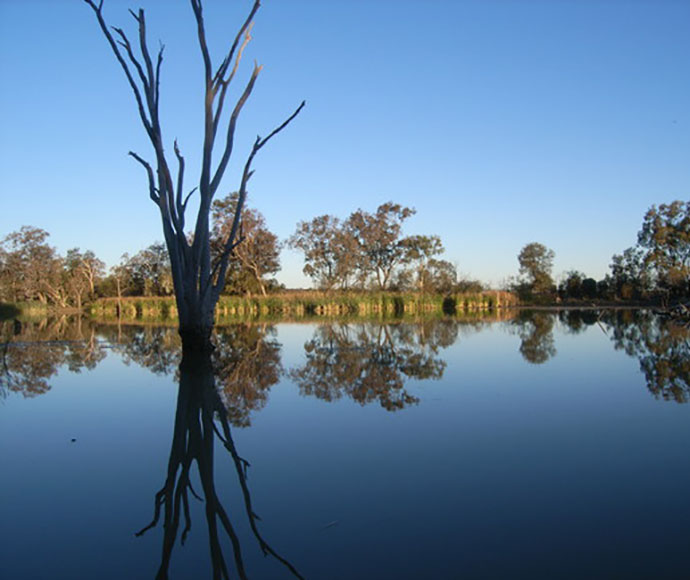The Gwydir Wetlands are an example of terminal delta wetlands, which are found when a river delta occurs in an inland valley. They are among the few inland wetlands of this kind remaining in the Murray–Darling Basin.
The Ramsar site consists of 4 separate subsites around the Gingham Watercourse and Lower Gwydir (also known as the Big Leather Watercourse). These subsites within the Gwydir Wetlands are:
- Crinolyn
- Goddard’s Lease
- Old Dromana
- Windella.
Together, the whole Ramsar site covers 823 hectares. It is part of a wider area of wetlands that originally covered 220,000 hectares but has been substantially reduced due to land use change and river regulation.

Gwydir Wetlands became a Ramsar site in 1999.
Why these wetlands were listed as a Ramsar site
Countries that sign up to the Ramsar Convention can nominate sites to be listed as Wetlands of International Importance (Ramsar sites). The site must meet at least one of 9 internationally accepted criteria.
The Gwydir Wetlands were listed as a Ramsar site in 1999 because they meet the following criteria.
Criterion 1: Representative or unique wetlands
The Gwydir Wetlands are a good example of an inland terminal delta in the Murray–Darling Basin. The Ramsar site includes representative examples of seasonally inundated grass/sedge meadows and some wooded swamp wetland types.
Criterion 2: Threatened species or ecological communities
The Ramsar site supports threatened species, including the Australasian bittern and Australian painted snipe.
Criterion 3: Populations of plants and/or animals important for maintaining biodiversity of a particular bioregion
The Gwydir Wetlands support diverse floodplain wetland communities characteristic of the Murray–Darling Basin drainage division, including grass/sedge meadows, cumbungi beds and coolibah woodland.
The wetlands are one of only 2 areas (along with the Macquarie Marshes) in the Murray–Darling Basin with extensive water couch marsh.
The Old Dromana subsite supports a marsh club-rush sedgeland community, which is rare and declining in the bioregion.
The wetlands provide nesting and feeding sites for many waterbird species, with 65 waterbird species recorded in the Old Dromana subsite.
Criterion 4: Supports species at a critical stage of their life cycle or provides refuge in adverse conditions
The Gwydir Wetlands are an important breeding area for waterbirds, including egrets, herons, ibises, swans and rarer species such as brolgas and magpie geese.
The wetlands also provide important resting and staging points for migratory species protected under international agreements, including Latham’s snipe, cattle egrets and white-winged black terns.
During floods the Ramsar site can support large congregations of breeding colonial waterbirds that feed in the wetlands, with 47 species recorded as breeding in the Old Dromana subsite.
How the site is managed
Management of this Ramsar site is guided by the following:
- the site’s Ramsar information sheet
- a statement of interim management intent (SIMI) for the Gwydir Wetlands State Conservation Area, which includes the Old Dromana and Goddard’s Lease subsites
- the Ramsar Convention’s ‘wise use’ principles guide the Crinolyn subsite, which is managed as a grazing property
- the Gwydir Wetlands Adaptive Environmental Management Plan
- a restoration order applied to the Windella subsite.
The Windella subsite’s restoration order
In 2003, following clearing of native vegetation on the Windella subsite, a notification of likely change in the site’s ecological character was submitted to the Ramsar Secretariat, under article 3.2 of the Ramsar Convention. A restoration order is in place under the Environment Protection and Biodiversity Conservation Act 1999.
Threats to the Ramsar site
The main threats to this site’s ecological character include:
- irrigation for agriculture
- water diversion
- introduced plants such as lippia and water hyacinth in the lower Gwydir
- changed fire regimes
- grazing.